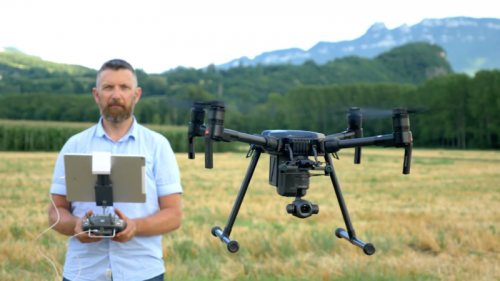The market for agricultural drones is growing, with applications ranging from fertilizer and pesticide spraying to detailed aerial mapping of farms and monitoring of crop health and disease.
One report estimates that by 2027, the market will be worth 480 million US dollars.
 Agricultural drones are also being used to help assess insurance claims for farmers. Image: Groupama/DJI
Agricultural drones are also being used to help assess insurance claims for farmers. Image: Groupama/DJI
Crop spraying in Japan’s rice fields
The idea of using agricultural drones in farming is not new. In Japan, for instance, Yamaha remote-controlled helicopters have been spraying rice crops since 1991.
Today, 2,500 of the firm’s remotely piloted helicopters spray pesticide on 35 percent of Japan’s rice fields.
Indeed, overall sales of sprayer drones in Japan have plateaued in what is now regarded as a mature sector for the technology.
Experts suggest that the Japanese sector is ready to be reinvigorated as lighter, cheaper agricultural drones enter the market.
Precision agriculture
Crop spraying is just one of the functions that agricultural drones can perform. They can also provide detailed aerial maps and gather surveillance data, helping farmers move into “precision agriculture.”
Today’s agricultural drones carry an array of equipment such as multispectral imaging sensors that assess plant health, levels of water stress, nitrogen deficiency, yields, and other vital measures.
In the past, the multispectral sensors were large and heavy and had to be mounted onto manned aircraft. This was very expensive and farmers could only afford to scan their crops a few times a year.
With today’s cheaper and lighter agricultural drones kitted out with more compact sensors, farmers can afford to survey their crops as often as they want, at a fraction of the cost.
Drones can also carry thermal imaging cameras for monitoring livestock, for instance, to see if any members of a herd are injured, missing, or giving birth.
Insurance claims assessment
Agricultural drones can also be used to monitor farmland remotely for security purposes and for helping insurance companies to rapidly and accurately assess agricultural claims.
Groupama, a leading French mutual insurance company that insures around 65 percent of France’s farmers, has developed a claims assessment system that is based on DJI Drone Platforms.
The idea is that the system will allow them to more accurately and quickly assess a claim, with many assessments being made on-site in minutes instead of days.
Another reason for the anticipated growth in the agricultural drone market is that the regulatory barriers for drone deployment are now coming down.
This time last year, a poll of farmers in the United States found that 33 percent of them said they would be using drones in 2017, while another 31 percent said they would be considering using them in 2018.
The growth in agricultural drones is also seen as part of a wider trend toward “smart farming.”
Video – agricultural drones helping farmers work smarter
The following video from Motherboard shows how Greg Crutsinger, a drone engineer, is helping farmers to use drone technology to meet the challenges posed by climate change and the need to make more efficient use of resources to grow more produce.
